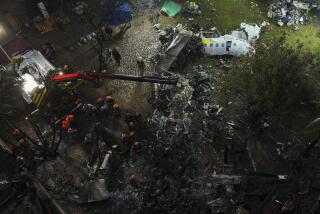‘Greater parts’ of plane detected
- Share via
PARIS — More bodies and debris were found Sunday near where an Air France jetliner with 228 people on board crashed into the Atlantic last week, according to reports from Brazilian and French military officials.
A Brazilian air force official confirmed that 17 bodies had been retrieved from the Atlantic Ocean in the area where Air France Flight 447 is believed to have crashed on June 1. He added that Brazilian radar-equipped planes had also found “greater parts of the plane’s body” below the surface.
The bodies, aboard French and Brazilian vessels, were being sent to the Brazilian mainland for examination and identification, he said. The official spoke on condition of anonymity because he was not authorized to speak on the matter.
Earlier in the day, French and Brazilian officials had reported a smaller number of bodies found.
All 216 passengers and 12 crew members are believed to have perished.
Search boats were sent through unfavorable weather conditions to retrieve other bodies seen by Brazilian aircraft earlier Sunday in the area about 400 miles northwest of Brazil’s Fernando de Noronha islands.
Dominique Bussereau, France’s transportation secretary, said it was too early to determine how the Airbus A330 crashed, based on this weekend’s findings.
“Disintegration in mid-flight, a shock or crash with the ocean’s surface -- for the moment no indication permits” authorities to narrow down their investigation, he said on RTL radio, adding that even an improbable terrorist attack was still being considered.
Meanwhile, Air France said it was accelerating a recently launched program to replace devices on A330s that measure airspeed. The airline denied that it had not responded to a previous Airbus manufacturer recommendation to replace the devices, called pitot tubes.
“Without making any assumptions as to a possible link with the causes of the accident, Air France speeded up this program [to replace the airspeed detectors] and reminded its pilots of the current instructions issued by the manufacturer to cope with the loss of airspeed data,” said a statement issued late Saturday.
French investigators said Saturday that Flight 447 emitted automatic messages indicating an “incoherence” in flight speed readings before the crash.
A malfunctioning airspeed sensor could possibly cause the computer controlling the plane to accelerate or decelerate in a potentially dangerous way, said Bussereau on RTL radio Sunday, while insisting that inconsistent speed readings “can’t be the only reason for a crash.”
In its statement, Air France said that refraining from following an Airbus recommendation made in September 2007 to replace pitot tubes was not viewed as a safety concern.
“A recommendation from the manufacturer gives the operator total freedom to apply the corresponding guidelines fully, partially or not at all,” the statement said. “Should flight safety be concerned, the manufacturer, together with the authorities, issues a mandatory service bulletin followed by an airworthiness directive.”
After the recommendation, the airline replaced the pitots on its Airbus A320 models because water occasionally leaked into the device on those planes, Air France confirmed. A replacement program “was not implemented on the A340/330s as no such incidents had been noted,” it added.
The airline said that in May 2008 it noted “incidents involving a loss of airspeed data in flight” on the A340s and A330s and asked Airbus to help fix the problem, which once again concerned pitots that froze briefly at higher altitudes.
But Airbus told the airline that its newer pitot models were “not designed to prevent such incidents which took place at cruise levels and reiterated the operational procedures well-known to the crews” for solving unreliable speed readings encountered on the A340 and A330 planes, according to Air France.
As a result, and after tests performed this year “suggesting” the new pitots might be “a valuable improvement to reduce the incidence” of pitot icing, Air France said that on April 27 it began replacing the older pitots on all Airbus models without waiting for Airbus to complete an in-service evaluation of the problem.
Airbus spokesman Stefan Schaffrath said he could not comment on the manufacturer’s response to Air France’s request to improve the pitots on its Airbus A340s and 330s because information regarding Flight 447 could be communicated only to French investigators.
Schaffrath did note that “it is absolutely not proven that [a problem with airspeed reading] led to the accident.”
He added that on Thursday night Airbus issued a reminder to pilots of its aircraft on the procedure for handling “inconsistencies in the speeds measured,” which Schaffrath termed a common and minor problem.
When asked if a malfunctioning pitot would result in an irregular speed reading, Schaffrath said he could not comment, but cautioned against jumping to conclusions.
“It is a long way from the measuring device to the cockpit,” he said.
--
Lauter is a special correspondent.
More to Read
Sign up for Essential California
The most important California stories and recommendations in your inbox every morning.
You may occasionally receive promotional content from the Los Angeles Times.













